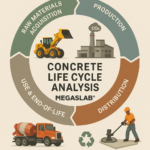As the foundation of modern development, concrete shapes our environments. However, its environmental cost prompts serious discussions, urging a balance between progress and preservation. This article delves into concrete’s ecological impact, discussing its environmental consequences and highlighting innovative solutions.
The Scale of Concrete Consumption: A National Perspective
The U.S., with its vast urban landscapes and infrastructure projects, stands as a testament to the extensive use of concrete. From skyscrapers in New York to highways stretching across states, concrete is omnipresent. This extensive demand not only underscores concrete’s pivotal role in development but also brings to light the environmental repercussions at a national scale. As urban areas expand and infrastructure needs grow, the U.S. faces the dual challenge of meeting development goals while ensuring sustainability. The balance between these objectives is crucial for the nation’s future.
The Carbon Footprint of Concrete
Concrete production, particularly cement, accounts for about 8% of global CO2 emissions. The process of converting limestone and other raw materials into cement requires high temperatures, consuming substantial energy and releasing CO2 due to chemical reactions. The Environmental Protection Agency (EPA) notes that producing one ton of cement results in nearly an equivalent amount of CO2 emissions. This carbon-intensive procedure amplifies greenhouse gas emissions, marking concrete as an environmental concern. To learn about innovative solutions to this problem, read about how low-carbon concrete reduces the carbon footprint, offering a more sustainable approach to concrete production.
Water Consumption: Concrete’s Thirsty Side
Concrete production demands significant water resources:
- Curing of Concrete: 40%
- Mixing and Production: 35%
- Dust Control: 15%
- Equipment Cleaning: 10%
Data from the U.S. Geological Survey emphasizes the need for water-saving strategies in concrete production, especially in regions facing water shortages. The curing process, vital for concrete’s durability, is notably water-intensive.
Resource Scarcity: Eroding Foundations
Concrete production impacts natural resources. Sand extraction, a primary component in concrete, affects river ecosystems and biodiversity. The industry’s water use is noteworthy, representing 9% of industrial water usage, as mentioned in a recent report by Nature magazine. The quest for raw materials not only exhausts natural reserves but also leads to air pollution and habitat disturbances. Contemporary concrete formulations often incorporate elements like fly ash and micro silica, which improve concrete quality and offer environmental advantages.
Overlooked Environmental Impacts
Concrete’s environmental repercussions are not limited to CO2 emissions:
- Heat-Island Effect: Dense concrete urban areas register elevated temperatures, resulting in higher energy use and potential health issues. This effect intensifies urban heatwaves, affecting air quality and fostering conditions that can lead to respiratory ailments.
- Respiratory Concerns: Concrete dust, containing crystalline silica, poses health risks. The Occupational Safety and Health Administration (OSHA) has set strict exposure guidelines.
- Habitat Disruption: Extensive concrete structures can adversely affect local ecosystems, an issue often raised by environmentalists.
The Intersection of Concrete and Corruption: Environmental Implications
While the environmental impact of concrete is a primary concern, it’s essential to understand the role of corruption in exacerbating these effects. The construction industry, especially sectors heavily reliant on concrete, often faces ethical and transparency issues. The vast sums of money involved, the complexity of projects, and the multiple stakeholders can create opportunities for corrupt practices. This not only raises concerns about the integrity of the industry but also has direct and indirect implications on the environment. Here’s how:
- Environmental Bypass: Corrupt practices might lead to overlooking essential environmental regulations, allowing the use of environmentally harmful materials or methods.
- Unsustainable Practices: Bribery and corruption can result in unsustainable extraction of raw materials, like sand, impacting ecosystems.
- Wastage and Inefficiency: Projects awarded due to corrupt practices might lead to material wastage, amplifying concrete’s environmental footprint.
- Stifling Innovation: Corruption can hinder the adoption of environmentally friendly concrete alternatives or construction methods.
Waste and Recycling: A Concrete Problem
The construction sector is a major producer of waste, with concrete being a significant contributor. As structures reach the end of their lifecycle or undergo demolition, vast amounts of concrete waste are generated. While landfills have traditionally been the destination for this waste, this approach poses environmental and economic challenges. Understand the significance of durability in reducing waste by exploring why the durability of concrete is important in sustainable construction practices.
Recycling offers a promising solution. By crushing and repurposing concrete waste, we can reduce the need for newly extracted raw materials, thereby conserving natural resources and reducing the carbon footprint of concrete production. Moreover, recycled concrete can often match, if not exceed, the quality of its traditional counterpart. Despite its potential, barriers like regulatory hurdles, quality concerns, and lack of awareness can impede widespread adoption.
Embracing concrete recycling is more than just an environmentally conscious decision; it’s an economically sound approach. As the industry grapples with its environmental impact, turning to recycled concrete can be a step in the right direction.
Discover how green concrete is paving the way for sustainable future construction, addressing these environmental challenges.
Innovations and Solutions: Building a Sustainable Future
Concrete’s impact goes beyond mere physicality. Meeting the twin demands of growing populations and sustainable development is a challenge for the construction sector.
Corporate Responsibility: Setting Stronger Foundations
Acknowledging environmental challenges, several entities in the cement industry are working towards sustainable futures. With a focus on reducing carbon emissions, they’re setting ambitious goals. Partnerships with technology companies, especially in carbon valorization, hint at a future where the industry leans towards a circular economy.
Alternative Binders
Researchers are exploring alternatives to Portland cement, the primary binder in concrete, which is responsible for a significant portion of its carbon emissions. Fly ash, slag, and natural pozzolans are being used as supplementary cementitious materials.
Carbon Capture and Storage (CCS)
Some companies are integrating CCS technologies into their production processes. These systems capture CO2 emissions at the source, preventing them from entering the atmosphere. The captured CO2 can then be stored or utilized in other applications.
Self-healing Concrete
This innovative solution involves embedding bacteria within the concrete that can produce limestone. When cracks appear, the bacteria are activated, filling the cracks with the produced limestone, reducing the need for repairs and increasing the lifespan of the concrete structure.
Lightweight Concrete
By using lightweight aggregates, such as expanded glass beads or perlite, the overall weight of concrete structures can be reduced. This not only saves on materials but also reduces the energy required for transportation and construction.
3D Printing with Concrete
3D printing technology allows for more precise use of concrete, reducing waste. It also enables the creation of innovative structures that would be challenging to achieve with traditional construction methods.
Root Veggies
Researchers have found ways to use vegetables like beets or carrots in concrete mixes. Nano-platelets from these veggies, when mixed with cement, strengthen the mixture and reduce the overall cement requirement.
Green Concrete
Green concrete is an innovative approach to concrete formulation and production that emphasizes environmental sustainability. It incorporates eco-friendly materials, reduces carbon emissions, and often utilizes recycled components. The primary goal of green concrete is to reduce the environmental footprint of concrete production while maintaining, or even enhancing, its strength and durability.
MEGASLAB is at the forefront of engineered slab concrete and industrial concrete flooring solutions, emphasizing a “STRONGER. GREENER. NO COMPROMISE.” approach. Serving a range of industries, from Heavy Equipment to Food and Beverage, our green concrete solutions are trusted for their exceptional durability and performance. MEGASLAB is setting a new industry standard with its revolutionary engineered low carbon concrete system, aiming for both strength and sustainability. See why our concrete can be a great alternative to traditional concrete.
Policy and Advocacy: Regulations for Renovation
The demand for stricter regulations concerning emissions, resource utilization, and waste management is intensifying. Concrete’s environmental implications are a focal point in global forums like COP27, signaling a shift towards policy-driven solutions. The construction industry, especially in developing nations, faces the aftermath of extreme climatic events intensified by global warming. The requirement for robust infrastructure projects, resilient against such events, is spurring innovations in concrete construction.
Consumer Awareness and Choices: The Power to Influence
As much as industries and policymakers play a role, consumers also wield significant influence over the environmental impact of concrete. Their choices can drive demand for sustainable alternatives:
- Eco-friendly Construction: An increasing number of consumers are opting for green buildings, pushing the industry towards sustainable practices.
- Support for Recycling: By choosing projects that utilize recycled concrete, consumers can promote its use and reduce the demand for newly extracted materials.
- Advocacy and Awareness: Engaged consumers can advocate for stricter regulations and raise awareness about the environmental impacts of concrete, influencing both industry practices and policy decisions.
A Path Forward
Concrete has shaped our world, but its environmental cost is clear. Moving forward, we all—industries, policymakers, and consumers—need to work together. By choosing sustainable practices and innovations, we can build a future where progress doesn’t come at the planet’s expense. It’s a big challenge, but together, we can strike the right balance.




